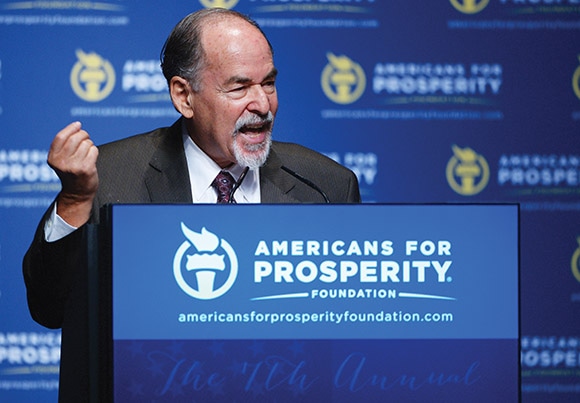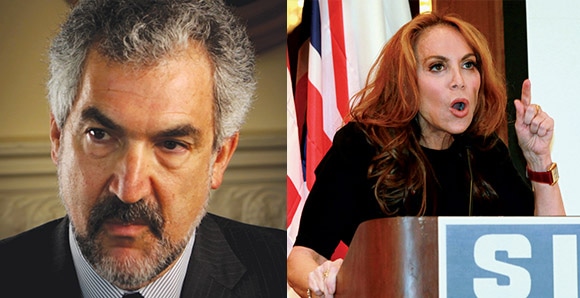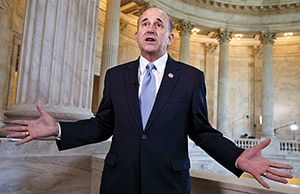Former Marxist intellectual David Horowitz, after a radical swing to the other end of the political spectrum, has become a leading purveyor of anti-Muslim propaganda.
For David Horowitz, the godfather of the modern anti-Muslim movement, the culture war that began when he was young never ended. Only the target has changed.
As one of the founding Marxist intellectuals of the New Left in the 1960s, Horowitz was a self-professed political radical — a pugnacious advocate of civil rights and equality. Now, a half-century later, he has undergone an about-face and set his sights on Muslims.
For Horowitz, Muslim Student Associations “are arms of the Muslim Brotherhood, which is the fountainhead of the terrorist jihad against the West.” Hillary Clinton adviser and Muslim Huma Abedin is a “Muslim Brotherhood operative” who is “worse than Alger Hiss.” And the Palestinians, all of them, are even worse.

“No people have shown themselves as so morally sick as the Palestinians,” Horowitz said. “In the history of all mankind, there was never a people who strapped bombs on their bodies and killed innocent people. No other people has sunk so low as the Palestinians, and everyone is afraid to say it.”
In the last decade, Horowitz has become a respected elder of a growing movement of hawkish neoconservatives, conspiracy theorists and former federal officials united in their twisted fears that Islam is on the march — a movement he describes in Orwellian terms as a “counterjihad.”
Through his David Horowitz Freedom Center, a wealthy nonprofit based in Sherman Oaks, Calif., he has financed leading Islamophobes driving public opinion and attacked universities as leftist “indoctrination” programs. He leads several conservative publications, all dedicated to tenaciously defending Israel and viciously attacking Islam as a religion of “hate, violence and racism.”
A report from the liberal think tank Center for American Progress, “Fear, Inc.,” exposed Horowitz as a prominent member of a “small network [that] produces talking points and messages relied upon and repeated by every segment of this interconnected network of money, grassroots leaders, media talking heads, and elected officials.” The report’s author, Wajahat Ali, chastised Horowitz as a self-serving and toxic presence in a field of anti-Muslim pundits.
Virulent Muslim-basher Robert Spencer, director of the website Jihad Watch, is on his nonprofit’s payroll, and Horowitz’s online FrontPage Magazine publishes the work of Daniel Greenfield and Daniel Pipes, both of whom add to right-wing fears that Muslims are infiltrating the West. Horowitz also works closely with Pamela Geller, collecting money for her anti-Muslim hate group, Stop Islamization of America.
What led Horowitz to this moment, such that he seems to have abandoned his former radicalism for civil rights in favor of blind rage against the left-wing of American politics and now Muslims? At 75, is it merely an overcorrection to views he held as a young man? Or, as his parents were communists, is it as the New York Times Magazine described, a “fierce Oedipal struggle entwined with radicalism”?
“He’s a person who is, first and foremost, a self-promoter, who has used his name to champion political causes and used the guise of media and freedom and democracy and free speech to actually inject poison into the pluralist racial and religious dynamic of America,” Ali told the Intelligence Report.

Red Diaper Baby
For a man who was raised in the heart of the Communist Party, who saw his parents targeted by McCarthyism, it seems needless to point out the irony of Horowitz’s worry that radical Islamists have infiltrated the halls of American power with nefarious plans to tear down constitutional freedoms.
David Joel Horowitz was born on Jan. 10, 1939, in Forest Hills, N.Y., a neighborhood in Queens, to parents who were both schoolteachers and members of the Communist Party USA. It was an exciting childhood, filled with intrigue.
“Underneath the ordinary surfaces of their lives, my parents and their friends thought of themselves as secret agents. … Even if we never encountered a Soviet agent or engaged in a single illegal act, each of us knew that our commitment to socialism implied the obligation to commit treason, too,” Horowitz recounted in his 1998 memoir, Radical Son.
His family eventually broke from the party after Soviet General Secretary Nikita Khrushchev delivered his 1956 speech “On the Cult of Personality and Its Consequences,” which outlined violations of human rights under Joseph Stalin. It was also that year that Horowitz graduated from Columbia University with a degree in English and left for London to work at the Bertrand Russell Peace Foundation, returning home in 1968 to lead Ramparts, the political and literary magazine of the “New Left” — a movement of liberal activists seeking to drastically reform the cultural landscape with a wide range of social reforms.
The magazine was shuttered in 1975, but by that time Horowitz was already in the Bay Area working for the Black Panthers and quickly became a confidant of the group’s co-founder, Huey P. Newton. It wasn’t long before that relationship began to sour, beginning with the murder of Betty Van Patter, a bookkeeper at Ramparts who Horowitz had brought to the Panthers. On Dec. 13, 1974, she disappeared from the Berkeley Square tavern in Berkeley. Her body was found in San Francisco Bay.
As fate would have it, it was then, as the wave of left-wing activism born in the 1960s began to break, that Horowitz felt the first rumblings of doubt regarding his political views.
Horowitz was convinced that Van Patter’s murder led directly to the Panthers, and her death plunged him into a depressive episode revolving around his inability to marry his political convictions with what he feared was a harsher reality — that the very people he thought were the answer to the world’s injustice had carried out her murder. “It was inconceivable to me that the Panthers would kill Betty Van Patter,” he wrote, despite coming to believe exactly that.
The Black Panthers were never officially tied to Van Patter’s death, but the event proved to be decisive in guiding Horowitz’s political future.
Spurred by his doubts and perhaps the prevailing political winds, Horowitz leaned increasingly right on issues such as sexual promiscuity in the gay community and LGBT rights, U.S. foreign policy, the question of racial equality and affirmative action. But it wasn’t until 1985 that Horowitz would make an entrance as a major player on the conservative right.
That year, Horowitz publicly announced that he had voted for Ronald Reagan in the presidential election, an act of political treason to his allies.
In a coming-out essay titled, “Goodbye to All That” and published in The Washington Post, Horowitz and his writing partner Peter Collier chastised the Left and set out to break ranks, once and for all, with all they knew. “Casting our ballots for Ronald Reagan was indeed a way of saying goodbye to all that — to the self-aggrandizing romance with corrupt Third Worldism; to the casual indulgence of Soviet totalitarianism; to the hypocritical mainstream politics,” the pair wrote.
Horowitz had changed.
Enemies Everywhere
Fueled by a bitter sense of betrayal, and a hunger to correct the errors of his own personal politics, Horowitz carried the bare-knuckled activism he practiced in the tumultuous 1960s into the heart of the modern conservative movement.
In 1988, he formed the Center for the Study of Popular Culture (CSPC) in Los Angeles, hoping, according to the group’s website, to “establish a conservative presence in Hollywood and show how popular culture had become a political battleground.” He had minor successes, including getting PBS to broadcast a documentary about the horrors of communist Cuba.
Then Horowitz turned his attention to targeting “tenured radicals” at American universities. He went after them with a fevered intensity, publishing the tabloid “Heterodoxy” to present conservative interests to university students who, he feared, were being indoctrinated by the entrenched Left. He began tracking the activities of liberal professors — an effort designed, more honestly, to target intellectuals with views at odds with his own.
He was prolific. He published wild tracts and pamphlets, including “Hating Whitey,” which argued that modern black leaders had squandered the legacy of the civil rights movement by restructuring “the civil rights agenda as a radical cause.” In a book of that same title, published in 1999, he made white nationalist claims about black-on-white crime, voicing criticisms of affirmative action that would last through the election of President Obama, who he called a communist with a “curious background.” Horowitz went on a crusade against reparations for slavery. He has attacked minority “demands for special treatment” as “only necessary because some blacks can’t seem to locate the ladder of opportunity within reach of others,” rejecting the idea that they could be the victims of lingering racism.
“The fact is that it is not tolerable in America to hate blacks, but it is okay in our politically correct culture to hate white people,” he wrote in “Hating Whitey.
“Of course, the leftist academy has a ready answer for every question about black racism: Only whites can be racist.”
But it wasn’t until after the Sept. 11 terrorist attacks that Horowitz discovered a new enemy in “radical Islam.” In 2006, the CSPC was rebranded as the David Horowitz Freedom Center, focusing its attention on “the efforts of the radical left and its Islamist allies to destroy American values.” Horowitz began financing Jihad Watch, a quasi-academic blog that spreads misinformation about Islam.
Directed by Robert Spencer, a Catholic, the blog aims to “track the attempts of radical Islam to subvert Western Culture.” It is popular among those who see the mere presence of Muslims outside the Middle East as a threat to freedom. His ideas have appealed to people such as Anders Breivik, the Norwegian who killed 77 people as a political statement against immigration. Breivik’s 1,500-page manifesto attacking multiculturalism, and especially Muslims, mentioned Spencer 162 times.
Since 2007, the Freedom Center has held annual Islamo-Fascism Awareness Week on multiple college campuses — 119 to date — to “protect students from indoctrination and harassment.” In reality, as with most of Horowitz’s public events, the program is focused on creating controversy, if nothing else.
During one such week in 2010, Horowitz appeared at the University of California-Santa Barbara. Midway through the program, he began to debate a Muslim student wearing a traditional Palestinian keffiyah — what Horowitz called a “terrorist neckerchief.” When the young woman asked Horowitz to clarify the connections he had been drawing between the Muslim Student Association on campus and radical terrorists, he instead asked the woman to denounce Hamas.
“For it, or against it?” he barked, demanding an answer. It was a trap.
While she would later claim she was thinking unclearly and intimidated, she bashfully replied, “For it.” Horowitz nodded and smiled. It was a rhetorical trick — the kind Horowitz has perfected. If she supported Hamas, Horowitz argued, the Muslim Student Association to which she belonged was actually tied to a terrorist organization, as defined by the State Department.
The video made the rounds on conservative news outlets, seeming to confirm for Horowitz and his followers that his fight with the “radical faith” was on target. Islam was on the move — everywhere.
Fueling the Fire
To understand the harm caused by Horowitz, it is important to see just how deep his influence goes on the political right. As the GOP becomes increasingly influenced by Tea Party politicians who bring conspiracy theories to the debate, Horowitz and his acolytes have emerged as the experts on radical Islam and its terrifying infiltration into American society and government.
Horowitz has accused anti-tax activist Grover Norquist of being a secret Muslim plant in the federal government. More famously, he has led the charge that Huma Abedin, a long-time aide to former Secretary of State Hillary Clinton, is a Muslim Brotherhood agent sent to “penetrate” the U.S. government. Horowitz argues that Abedin, who is married to former U.S. Rep. Anthony Weiner, has “been given a special dispensation to marry a Jew so she can infiltrate our government.”
“If you wondered how it’s possible that Obama and Hillary would not know or would pretend what was happening wasn’t happening in the Middle East, or how they could turn over Egypt as they have to the Muslim Brotherhood, which is the fountainhead of Al Qaida and all these terrible Islamic Nazi organizations, the answer is not really hard to find: the chief adviser to the American government on Muslim affairs,” Horowitz said in a 2012 radio interview with Janet Mefferd.
Yet, somehow, Horowitz has mostly avoided charges of racism or bias, often citing First Amendment protections and relying on young audiences of politically conservative college students — where the “leftist offensive is most visible” — to popularize his views and draw support. A gifted rhetorician, his attack on Islam is often couched in a defense of Israel and civil rights, or defended as necessary for security.
Given his annual salary of more than $540,000, according to federal tax filings from 2013, Horowitz has not avoided charges of political opportunism — a point made clear in his wildly vacillating history of political views.
In 1991, Fred Gardner, a former colleague at Ramparts, said Horowitz and his writing partner Peter Collier “were never radicals for a minute.” “Their goal was and is personal success. It’s no coincidence that they were ‘left’ in the ’60s and ‘right’ in the ’80s,” Gardner said.

Is it any wonder that Cruz has ranted that “Shariah law is an enormous problem” or that Gohmert has said, “This administration has so many Muslim Brotherhood members that have influence that they just are making wrong decisions for America”?
It is these connections to powerful politicians that are concerning, ensuring that Horowitz’s toxic activities affect the mainstream — and the lives of American Muslims.
“He hires the Luca Brasis of the anti-Islam movement,” Ali said, comparing Robert Spencer to Mario Puzo’s famed hitman from The Godfather. “He subsidizes. He gives them a platform. He enables and supports people who share his ideological vision. And what’s more dangerous than that?”


